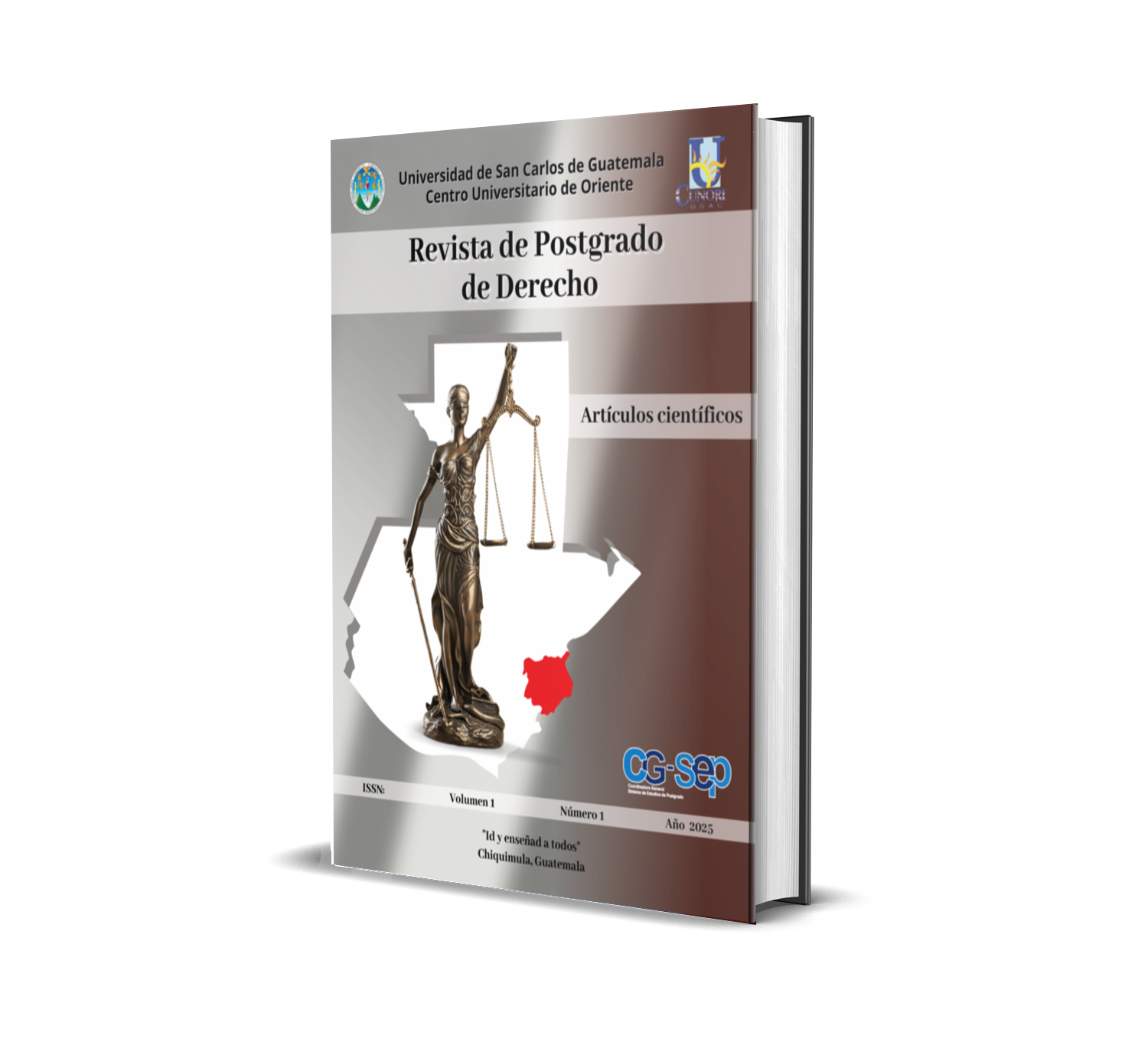Criminal Taxonomy
DOI:
https://doi.org/10.36314/postgradosderecho.v1i1.7Keywords:
taxonomy,, crimes, human rights, deprived of liberty, legal goodAbstract
PROBLEM: the violation of the Human Rights of those deprived of liberty in the effective protection of the human rights that correspond to them in accordance with the treaties, pacts and international instruments that regulate the inherent rights of the human person. OBJECTIVE: establish the impact that the adequate determination of the taxonomy of the criminal deprived of liberty has on the effective protection of the human rights that correspond to him. METHOD: the methods to be used in this research are inductive, starting from a particular notion to derive more general conclusions that will require being complemented with the deductive method, so that, with the latter, more particular elements can be derived about generalities. and international instruments that exist regarding the Human Rights of those deprived of liberty. RESULTS: there is no analysis related to the impact or injury to the protected legal property in order to separate those deprived of liberty. The taxonomy contributes and greatly expands the classification established in Nelson Mandela’s Rules and other international instruments. CONCLUSION: in Guatemala, as in other States, there is a violation of the Human Rights of those deprived of liberty due to the lack of a correct classification of those deprived of liberty. There is no program that allows comprehensive development and effective rehabilitation so that the prisoner becomes a useful entity to society.
References
Muñoz Anaya, A. Salvia. C. Gabriel (2021). Los Derechos Humanos en las relaciones internacionales y la política exterior, coedición fundación Kadal, Mexico. https://www.kas.de/documents/287460/4262432/Los-derechos-humanos-en-las-relaciones-internacionales-y-la-politica-exterior.pdf/961996d8-70e2-e128-b834-60f0651bb516?t=1622156281309
Carmona Tinoco, J. U, (2008). La recepción de la jurisprudencia de la Corte Interamericana de Derechos Humanos, en el ámbito interno. Biblioteca Jurídica Virtual del Instituto de Investigaciones jurídica de la UNAM. https://www.corteidh.or.cr/tablas/r28104.pdf
Declaración Universal de los Derechos Humanos, DUDH (1948), consultado 22/04/2024. https://es.wikipedia.org/wiki/Declaraci%C3%B3n_Universal_de_los_Derechos_Humanos
Donnell O, D, (2007). Derecho Internacional de los Derechos Humanos, Normativa, jurisprudencia y doctrina de los sistemas universal e interamericano, Oficina en México del Alto Comisionado de las Naciones Unidas para los Derechos Humanos, México. http://www.oda-alc.org/documentos/1374531071.pdf
Hefendehl R., Von Hirsch A, Wohlers W. (2016). La Teoría del Bien Jurídico Fundamento de Legitimación del Derecho penal o Juego de abalorios dogmático. Madrid, España. https://books.google.es/books?hl=es&lr=&id=6jq6EAAAQBAJ&oi=fnd&pg=PA5&dq=LA+TEOR%C3%8DA+DEL+BIEN+JUR%C3%8DDICO+ROLAND+H+HEFEND&ots=Pe2gt7kclv&sig=SdrjOuoDEJXPPR-LaQrezU5jMlM#v=onepage&q&f=false
Heinrich Jescheck, H. traducido por Olmedo Cardenete M. (1996). Tratado de Derecho Penal Parte General Volumen I, Pacífico Editores S.A.C, https://proyectozero24.com/wp-content/uploads/2021/09/Jescheck-2014-Tratado-Derecho-Penal.-Parte-General.-Volumen-I.pdf)
Mir Puig, S. (2003). Introducción a las bases del Derecho Penal, conceptos y métodos, Editorial S.R.L, Buenos Aires, Argentina. https://proyectozero24.com/wp-content/uploads/2021/09/Mir-Puig-2003-Introduccion.-Bases-Derecho-Penal.pdf
Naciones Unidas [ONU] (2016). Manual para Parlamentarios No. 26. Derechos Humanos Oficina de Alto Comisionado. https://www.ohchr.org/sites/default/files/Documents/Publications/HandbookParliamentarians_SP.pdf
Villanueva, R., (2017). Reglas Mínimas de las Naciones Unidas para el Tratamiento de los Reclusos, Comisión Nacional de los Derechos Humanos, México https://appweb.cndh.org.mx/biblioteca/archivos/pdfs/Reglas-Mandela-Reclusos.pdf
Villanueva, R, (2017). Reglas Mínimas de las Naciones Unidas para el Tratamiento de los Reclusos, Comisión Nacional de los Derechos Humanos. https://appweb.cndh.org.mx/biblioteca/archivos/pdfs/Reglas-Mandela-Reclusos.pdf
Oficina de las Naciones Unidas contra la Droga y el delito UNODC, (1977). Reglas Mínimas de las Naciones Unidas para el Tratamiento de los Reclusos, Reglas Nelson Mandela. https://www.unodc.org/documents/justice-and-prison-reform/Nelson_Mandela_Rules-S-ebook.pdf
Zaffaroni, E. R, (2001) Manual de Derecho Penal Parte General. México. Editorial Porrúa, Segunda Edición. https://penalparalibres.wordpress.com/wp-content/uploads/2018/06/penal-parte-general-zaffaroni.pdf
Zamora Jiménez, A. (2008), Bien Jurídico y Consentimiento en Derecho Penal, Letras Jurídicas Número 6. Consultado 01 de mayo de 2024 https://cuci.udg.mx/sites/default/files/bien_juridico.pdf
Published
How to Cite
Issue
Section
License
Copyright (c) 2025 Dina Consuelo Alvarado Ixtecoc

This work is licensed under a Creative Commons Attribution 4.0 International License.
Authors who publish with this journal agree to the following terms:
- Authors retain copyright and grant the journal right of first publication with the work simultaneously licensed under a Creative Commons Attribution License 4.0 that allows others to share the work with an acknowledgement of the work's authorship and initial publication in this journal.
- Authors are able to enter into separate, additional contractual arrangements for the non-exclusive distribution of the journal's published version of the work (e.g., post it to an institutional repository or publish it in a book), with an acknowledgement of its initial publication in this journal.
- Authors are permitted and encouraged to post their work online (e.g., in institutional repositories or on their website) prior to and during the submission process, as it can lead to productive exchanges, as well as earlier and greater citation of published work.





